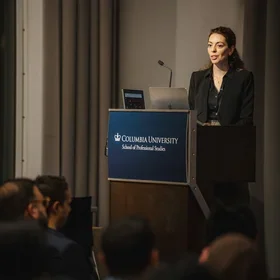Our Integrated Talent Management Strategies class recently had the pleasure of hosting Norm Celotto as a guest speaker on managing talent in matrix organizations. Norm is a senior leadership advisor on enterprise transformation and effectiveness. Prior to a 20-year tenure at Hay Group/Korn Ferry, Norm held roles in internal consulting and management with HSBC, Digital Equipment Corp., Hancock Natural Resource Group, and the State University of New York. His work has spanned several sectors, including financial services, manufacturing, health care, bio-pharmaceutical, technology, retail, FMCG, fashion, hospitality, professional services, transportation, food, communication, and entertainment.
Norm took the students through a discussion of the challenges and opportunities in managing talent in complex, matrix organizations. He shared the historical context of the evolution of organizational structure, from Function-based in the 1950s and 1960s, to Market-based in the 1970s and 1980s, and eventually Matrix-based structures emerging in the 1990s as a compromise of implications from the previous two. It was very insightful for our students to hear about how in the recent decade, there has been an increased focus on organizations encouraging employees to define what they can do in their roles, given the various complex forces interacting with the roles.
Key takeaways from Norm's discussion include:
- Matrix structures are appealing because they avoid the glaring weaknesses of the other forms (Function-based and Market-based). Still, they are complicated, challenging to implement, and require a lot of natural collaboration.
- Matrix structures have great value, especially as we are in a highly VUCA (Volatile, Uncertain, Complex, Ambiguous) world, and matrix allows organizations to "Think global and act local." It enables inter-connectivity, collaboration, and innovation.
- Research shows that characteristics of the most successful matrix/enterprise leaders are: Enterprise perspective, Cross-functional perspective, Customer perspective, Self-management, Listening with respect, Matrix influencing, and Enabling collaborative solutions.
- The biggest challenge for matrix leaders is how to network. Here, the concept of Social Capital can be very useful in expanding the network where you build relationships and share with others; think of networking not for yourself but for others.
- Some of the best practices in maximizing talent's value-added in a matrix organization include a solid "Change Management" methodology; Role clarification working sessions & supporting tools; Appropriate groupware (e.g., Teams); Matrix leadership development for all matrix leaders; Matrix leader assessments; and a cadre of transformational leaders, personally enrolled and led by executive leadership (C-Suite).
Our class truly enjoyed hearing from someone with such a depth of experience advising senior leaders and others on transforming organizations for impact. Thank you, Norm, for joining us!



